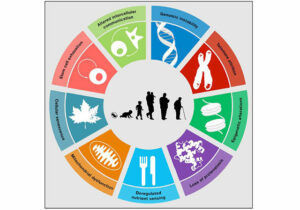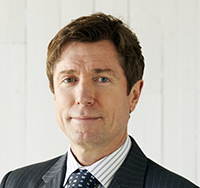HEALTHY AGEING?

Source: López-Otín et al. The hallmarks of aging. Cell. 2013
Scientifically, ageing is broadly defined as the time-dependent biological functional declines that affect most living things after they reach adulthood. However, humans don’t become elderly or old at any specific age, and age can be expressed in several different ways:
- Chronological age – simply a person’s age in years, based solely on the passing of time. The likelihood of developing certain health problems does increase as people become middle-aged, like developing type 2 diabetes, but disease is not in itself inevitable. People can simply die of old age.
- Biological age – refers to changes in the body that commonly occur as people get older. Because these changes affect some people sooner than others, some people are biologically old at 65, and others not until a decade or so later. Biological age is affected by lifestyle, habit, and the subtle effects of disease (or absence of disease) rather than by differences in actual aging.
- Psychological age – is based on how people act and feel. For example, a 70-year-old who works, plans, looks forward to future events, and participates in many activities is considered psychologically younger.
What causes ageing?
Recently, a group of European ageing experts proposed 9 main processes that are generally considered to contribute to the aging process:
- Genomic Instability – the accumulation of genetic damage due to physical, chemical, and biological agents, as well as by internal agents, including DNA replication errors, spontaneous hydrolytic reactions, and oxidative stress. Our cells have a complex network of DNA repair mechanisms that are collectively capable of dealing with most of the damages inflicted to nuclear DNA, but damage accumulates over time.
- Telomere Attrition – as discussed in this month’s Food for Thought and Diabetes Care, over time, telomere length decreases until the telomere becomes too short for cells to divide, resulting in their death.
- Epigenetic alterations – involve alterations in DNA methylation patterns, post-translational modification of histones, and chromatin re-modelling. Unlike DNA mutations, epigenetic alterations are theoretically reversible, offering opportunities for the design of novel anti-aging programs and treatments.
- Loss of protein homeostasis (proteostasis) – Proteostasis is altered with aging, when mechanisms for the stabilization of correctly folded proteins, and mechanisms for the degradation of proteins, no longer work effectively.
- Deregulated nutrient sensing – in particular in relation to the sensing of glucose and its effects on insulin and insulin-like growth factor 1 (IGF-1). Additionally, alterations in mechanisms for sensing amino acid concentrations and other energy sources are thought to be involved with ageing.
- Mitochondrial dysfunction – mitochondria are the power stations found inside most cells. Progressive mitochondrial dysfunction that occurs with aging results in increased oxidative stress, which in turn causes further mitochondrial deterioration and cellular damage throughout the body.
- Cellular senescence – is the gradual deterioration of functional characteristics in cells. Because the number of senescent cells increases with ageing, it has been widely assumed that senescence contributes to aging. However, it is possible that senescence is a beneficial compensatory response that helps to rid damaged and potentially cancer-causing cells.
- Stem cell exhaustion – Stem cells are the cells from which all other cells with specialized functions are generated. For example, stem cells in bone marrow develop into red blood cells. Stems cells, exhausted from advancing chronological age, are no longer able to produce enough specialised cells essential to normal bodily function.
- Altered intercellular communication – our cells communicate with each other by secreting a broad range of hormones (e.g., insulin, IGF1, adrenalin, etc…), often orchestrated by our nervous system. Their ability to do so decreases in aging as inflammatory reactions increase, immunosurveillance against pathogens and pre-cancerous cells declines, and the composition of the cellular environment changes.
Can we age healthily?
The existence of so-called “blue zones” around the world, where people live the longest, and are healthiest, suggest that yes, we can age healthily. The five places in the world that have been identified as having high rates of healthy ageing are:
- Okinawa, Japan
- Sardinia, Italy
- Nicoya, Costa Rica
- Ikaria, Greece, and
- Loma Linda, California.
Key characteristics of these populations include:
- Moving naturally. Rather than pumping iron or running marathons, live in environments that constantly encourage you to move without thinking about it. For example, grow gardens and do not use mechanical tools for house and garden work.
- Purpose. Have a sense of purpose – the Okinawans call it Ikigai and the Nicoyans call it plan de vida; for both, it translates to “why I wake up in the morning.”
- Downshift. Develop routines that decrease stress. Okinawans take a few moments each day to remember their ancestors; Adventists in Loma Linda pray; Ikarians take a nap; and Sardinians do happy hour!
- 80% Rule. Stop eating when your stomach is 80% full. People in the Blue Zones eat their smallest meal in the late afternoon or early evening, and then, they do not eat any more the rest of the day.
- Plant slant. Legumes, including fava beans, black beans, soy, and lentils, are the cornerstone of most blue zone diets. Seafood is also consumed regularly, but meat is only eaten occasionally. Serving sizes of meat are moderate (85 – 115 g, or 3 – 4 oz), which is roughly equivalent in size to a deck of playing cards.
- Wine. People in all Blue Zones (except Adventists) drink alcohol moderately and regularly. The trick is to drink 1 to 2 glasses per day, with family, friends and preferably with food.
- Belong. Research shows that attending faith-based services 4 times per month will add 4 to 14 years of life expectancy. Denomination does not seem to matter.
- Loved ones first. People in the Blue Zones put their families first. They commit to a life partner and invest in their children with time and love.
- Right tribe. The social networks of long-lived people favourably shape their health behaviours.
Read more:
-
López-Otín et al. The hallmarks of aging. Cell. 2013
-
Buettner and Skemp. Blue Zones: Lessons From the World’s Longest Lived. Am J Lifestyle Med. 2016








